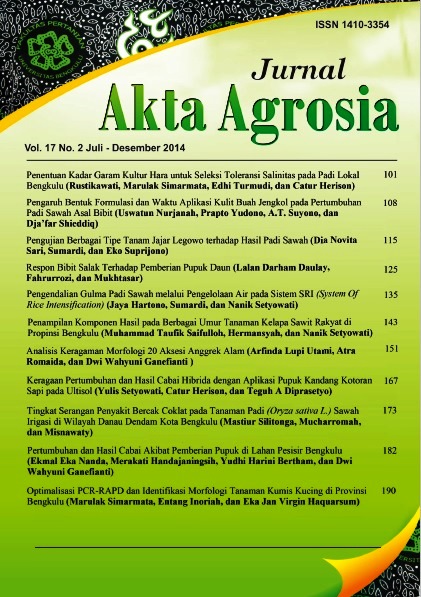Main Article Content
Abstract
The availability of high rate of transplanting succes is very important for early growth of snakefruit. An experiment aimed to identify both optimal concentration and frequency of foliar fertilizer application on growth
of snakefruit during nursery. The experiment was conducted in Pondok Kelapa, Bengkulu Tengah, from August to October 2008. Concentration and frequency treatments were arranged in a Split Plot base on a Randomized Complete Block Design. Spraying frequency (weekly, two-weekly or three-weekly) were used as the main plot;
whereas, concentration of liquid nutrient Hyponex Merah with composition of 25:5:20-N:P:K, consisted of 0, 2, 4 and 6 g L-1 water, was the sub-plot Results demonstrated that concentration of liquid nutrient significantly
affected seedling growth with optimum concentration for plant height was 4.6 g L-1, the greatest leaf number was 39 g L-1, the largest leaf area was 4.1 g L-1, the greatest stomata number was 4.2 g L-1, the greatest chlorophyl content was 3.9 g L-1 and seedling dry weight was 4.6 g L-1. Both frequency and its combination with concentration of foliar fertilizer had no significant effects on the growth snake fruit seedlings
of snakefruit during nursery. The experiment was conducted in Pondok Kelapa, Bengkulu Tengah, from August to October 2008. Concentration and frequency treatments were arranged in a Split Plot base on a Randomized Complete Block Design. Spraying frequency (weekly, two-weekly or three-weekly) were used as the main plot;
whereas, concentration of liquid nutrient Hyponex Merah with composition of 25:5:20-N:P:K, consisted of 0, 2, 4 and 6 g L-1 water, was the sub-plot Results demonstrated that concentration of liquid nutrient significantly
affected seedling growth with optimum concentration for plant height was 4.6 g L-1, the greatest leaf number was 39 g L-1, the largest leaf area was 4.1 g L-1, the greatest stomata number was 4.2 g L-1, the greatest chlorophyl content was 3.9 g L-1 and seedling dry weight was 4.6 g L-1. Both frequency and its combination with concentration of foliar fertilizer had no significant effects on the growth snake fruit seedlings
Article Details
License
Copyright (c) 2014 Lalan Darham Daulay, Fahrurrozi Fahrurrozi, Mukhtasar Mukhtasar

This work is licensed under a Creative Commons Attribution-ShareAlike 4.0 International License.
Authors who publish with this journal agree to the following terms:
- Authors retain copyright and grant the journal right of first publication with the work simultaneously licensed under a Creative Commons Attribution License that allows others to share the work with an acknowledgement of the work's authorship and initial publication in this journal.
- Authors are able to enter into separate, additional contractual arrangements for the non-exclusive distribution of the journal's published version of the work (e.g., post it to an institutional repository or publish it in a book), with an acknowledgement of its initial publication in this journal.
- Authors are permitted and encouraged to post their work online (e.g. in institutional repositories or on their website) prior to and during the submission process, as it can lead to productive exchanges, as well as earlier and greater citation of published work (See The Effect of Open Access).
How to Cite
Daulay, L. D., Fahrurrozi, F., & Mukhtasar, M. (2014). Respon Bibit Salak Terhadap Pemberian Pupuk Daun. Akta Agrosia, 17(2), 125–134. Retrieved from https://ejournal.unib.ac.id/Agrosia/article/view/1090
